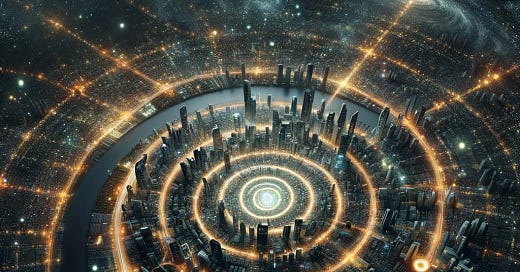Principles of Market Fundamentalism, No. 8: Emergence
The extended socioeconomic order is a product of human action, not human design.
Emergence <
Transaction Costs
Principle Eight
The extended socioeconomic order is a product of human action, not human design.
In comparing economies to evolutionary ecosystems, it is important to acknowledge that the Principle of Ecosystems has a twin: The Principle of Emergence. This principle states that the economy is a product of human actions, not human designs.
Continuing from the epigraph, economist and philosopher F. A. Hayek writes:
To the naive mind that can conceive of order only as the product of deliberate arrangement, it may seem absurd that in complex conditions order, and adaptation to the unknown, can be achieved more effectively by decentralizing decisions and that a division of authority will actually extend the possibility of overall order.
From this insight, we might surmise that organizations, at least, can be designed and planned, but agree with Hayek that whole economies cannot.
Hayek would have been enchanted by the new organizational forms made possible through new technology and new rules that lower transaction costs.
Swarm Order
Leif Smith, who publishes Freeorder, said he had coined the term Freeorder to describe “the harmonious balance between planned order and spontaneous evolution in free societies,” which artist-entrepreneurs create. Smith wondered what F. A. Hayek would have thought about the term, so asked an AI trained in Hayek’s writings. Turns out AI-Hayek liked Smith…
It turns out that the Principle of Emergence can operate within organizations, too, and given the proper internal protocols, these organizations will become increasingly competitive.
Note: In a past exchange, a reader and I got a bit tangled up over my use of “emergent order” as more or less interchangeable with “spontaneous order,” which Hayek uses.
So, I want to acknowledge that emergence, particularly in the context of emergent complexity, refers to a phenomenon where larger entities, patterns, or behaviors arise through the interactions among smaller or simpler entities that do not exhibit such properties when considered in isolation. This concept is crucial for understanding complex systems. Emergent complexity suggests that complex structures and behaviors can evolve from relatively simple rules or interactions, leading to unforeseen or unpredictable outcomes. (See, for example, Stuart Kauffman on autocatalytic sets.)
Perhaps my use of emergent order is part aesthetic, part connotative. It captures the idea of order that results from human action without design. But it also captures that the overall order has properties that the constituent human actions lack. Instead of fussing about the matter, let’s imagine two Venn Diagram circles—one “spontaneous order” and one “emergent complexity.” Also imagine these overlap to a very great degree. Let’s call that overlap “emergent order.”






